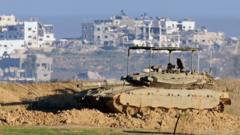The regions of Gaza and Israel find themselves on the cusp of a potential ceasefire agreement after 15 months of relentless warfare, which escalated following Hamas's attack on Israeli territory in October 2023. As negotiations reportedly progress, the focus centers on not only halting hostilities but also facilitating humanitarian aid and the exchange of captives.
Displacement and Humanitarian Crises
The conflict has led to widespread displacement, with nearly the entire population of Gaza—approximately 2.3 million individuals—forced to flee their homes due to ongoing violence. Humanitarian agencies face significant challenges in delivering aid, further exacerbating the pressing needs of civilians trapped in war-torn areas. Any ceasefire arrangement must prioritize the return of displaced populations and the provision of essential services.
Details of the Proposed Ceasefire
In recent reports, sources indicate that the ceasefire would occur in a phased manner, starting with the exchange of 34 civilian hostages for Palestinian prisoners. A simultaneous Israeli withdrawal from densely populated areas of Gaza is anticipated, marking the initial stage of the ceasefire. Subsequent phases would negotiate the release of remaining military personnel and expand the scope of prisoner exchanges.
The negotiations outline an approach where approximately 1,000 Palestinian prisoners, some serving long sentences for serious offenses, might be released in return. There are lingering concerns regarding the fate of hostages, as Israel asserts that only a fraction of those initially captured by Hamas are still alive.
Complexities and Uncertainty
The pathway to a formal ceasefire is fraught with complexity. Mistrust between the parties complicates the discussions, with Hamas demanding full cessation of hostilities while Israel seeks guarantees against future attacks. As both sides grapple with their mutual grievances, the likelihood of a sustainable peace remains uncertain. Historical precedents of ceasefires collapsing due to violations highlight the precarious nature of any agreement.
Concluding Thoughts on the Current Situation
As negotiations continue, critical questions remain regarding the long-term impact of a potential ceasefire on regional stability and security. The desire for reconstruction in Gaza contrasts sharply with the ongoing security concerns of Israel, raising questions about the feasibility of an enduring resolution. The implications of such developments extend not only to the immediate region but also to the global diplomatic landscape focused on the Israeli-Palestinian conflict.
Displacement and Humanitarian Crises
The conflict has led to widespread displacement, with nearly the entire population of Gaza—approximately 2.3 million individuals—forced to flee their homes due to ongoing violence. Humanitarian agencies face significant challenges in delivering aid, further exacerbating the pressing needs of civilians trapped in war-torn areas. Any ceasefire arrangement must prioritize the return of displaced populations and the provision of essential services.
Details of the Proposed Ceasefire
In recent reports, sources indicate that the ceasefire would occur in a phased manner, starting with the exchange of 34 civilian hostages for Palestinian prisoners. A simultaneous Israeli withdrawal from densely populated areas of Gaza is anticipated, marking the initial stage of the ceasefire. Subsequent phases would negotiate the release of remaining military personnel and expand the scope of prisoner exchanges.
The negotiations outline an approach where approximately 1,000 Palestinian prisoners, some serving long sentences for serious offenses, might be released in return. There are lingering concerns regarding the fate of hostages, as Israel asserts that only a fraction of those initially captured by Hamas are still alive.
Complexities and Uncertainty
The pathway to a formal ceasefire is fraught with complexity. Mistrust between the parties complicates the discussions, with Hamas demanding full cessation of hostilities while Israel seeks guarantees against future attacks. As both sides grapple with their mutual grievances, the likelihood of a sustainable peace remains uncertain. Historical precedents of ceasefires collapsing due to violations highlight the precarious nature of any agreement.
Concluding Thoughts on the Current Situation
As negotiations continue, critical questions remain regarding the long-term impact of a potential ceasefire on regional stability and security. The desire for reconstruction in Gaza contrasts sharply with the ongoing security concerns of Israel, raising questions about the feasibility of an enduring resolution. The implications of such developments extend not only to the immediate region but also to the global diplomatic landscape focused on the Israeli-Palestinian conflict.




















